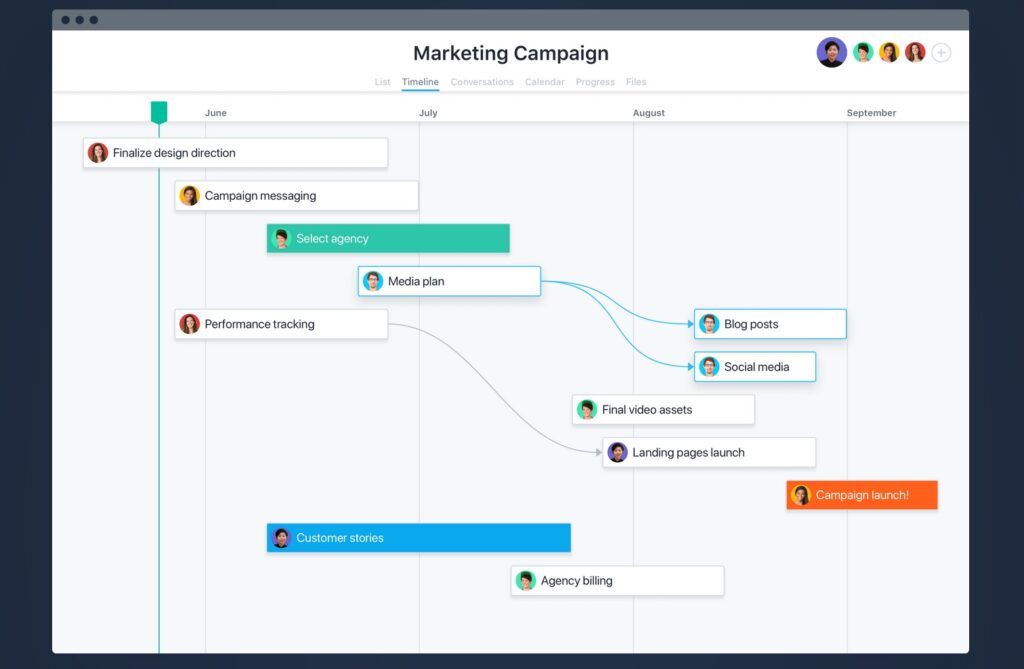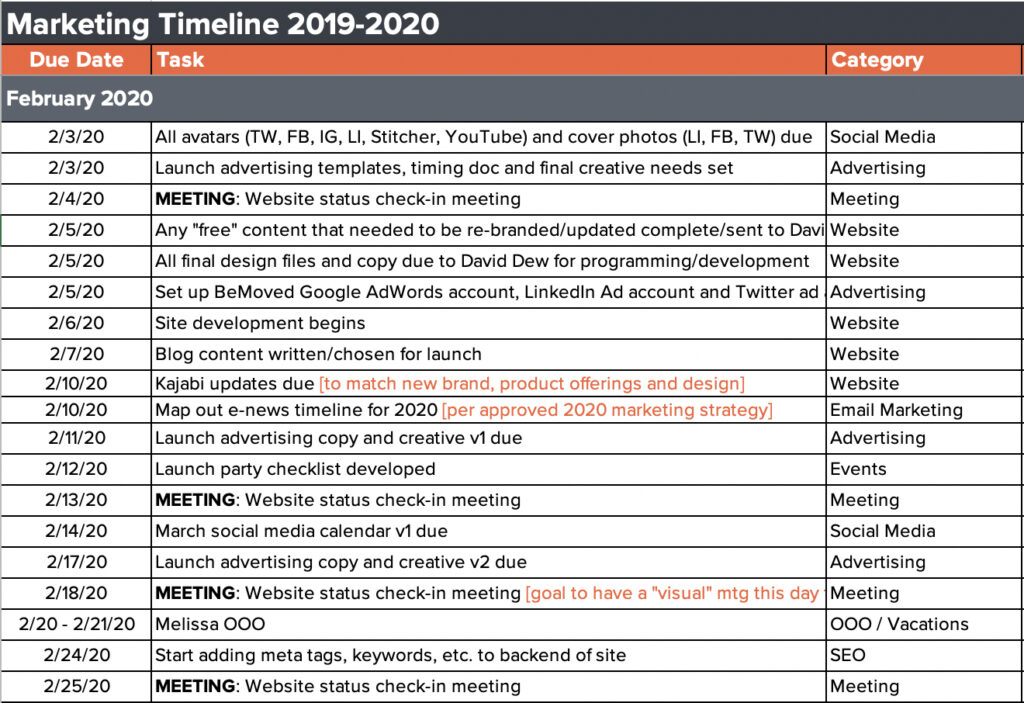
Today, I’m taking a different spin on how to set up your marketing plan by skipping the elements to include in your plan (if you do need them, grab them here) and approaching the post by using what we know from our success (or failures) from the previous year. It’s a simple planning strategy broken into three key areas: metrics, goals and process.
Metrics: What do you know from last year?
Marketing plan metrics is a two-phase approach. First, evaluate your metrics from last year in order to gather information on what worked, what didn’t and what is even feasible for the coming year. The most efficient way to do this is to track and evaluate throughout the year. But, sometimes that doesn’t always happen, so to get you started, here is a sample list of questions and information, broken into various channel categories, that will be helpful for you to evaluate as you think about your goals. Add additional questions based on tactics and channels you use (i.e. gated content, video success, events, direct mail).
Website
- What was your overall traffic (by year, by month)?
- What were the top performing pages on your site (by user, by session, by entrance)?
- Where did your users come from (location)?
- How did users get to your site (referral links, direct, paid campaign, social media, email marketing)?
Social media
- Which channels had the most engagement?
- What is the demographics of users (by engagement, by fan base) for each channel?
- What type of content generated the most clicks?
- Which channels led the most users to your website?
Email marketing
- What was your average open rate?
- What was your average click through rate?
- What was your overall bounce rate and/or unsubscribe rate?
- Which subject lines performed the best?
- What time of day was most successful for opens?
Sales
- Where did the largest percentage of revenue come from (i.e. referrals, website, in-person)?
- What are the demographics of those that made up the bulk of your sales this year?
- How did people hear about you?
Paid media
- Which channel proved most cost effective (i.e. cost per click, cost per impression, etc.)?
- Which tactic garnered the highest conversions?
- Which ad(s) brought the most traffic to your website?
Phase two of your marketing plan metrics is done in conjunction with goal setting. As you set your goals (based on last year’s metrics) you will establish new metrics for defining success. On a simple marketing plan, it might look something like this:
Goal #1:
Metric(s) to track success:
Goal #2:
Metric(s) to track success:
Goals: What do you want to achieve this year?
Are your goals feasible based on what you know from last year’s data? For instance, if you want to increase your brand’s presence in another state or country but you only saw a 1% increase in that particular demographic of website traffic over the prior year, it’s probably not feasible to set that goal at 50%. Likewise, if you know that Instagram refers 70% of your website traffic, you wouldn’t want to skip that channel as a means to distribute content this year.
Spend time assessing your metrics and evaluating the channels worked, those that didn’t and those that would make the most sense to concentrate on for the next year.
Keep in mind that business goals are what you’re setting out to achieve; marketing goals and tactics are set to support those goals. Your goals may be centered around any one of the following:
- Increase market share in X area
- Launch a new product
- Refresh your brand
- Increase revenue
- Add team members, new clients, additional customers
Let’s put this into practice.
Situation: Company A sells eco-friendly Tshirts across the U.S. They have been in business for three years and have been well-received by a younger demographic set (Gen Y, Gen Z). Ninety percent of their sales happen online, the other ten percent happen at in-person events. While they have not ventured into online advertising, they do have an aggressive goal of increasing revenue by 30% in the next year so that they can add additional team members which will provide them with resources to introduce new items to their product line.
Metrics findings: Instagram was the number one driver of traffic to the brand’s website in 2019. Company A also found that when users landed on blog posts that offered CTAs back to product listings, 25% of readers clicked on those links and browsed product offerings.
Business goal: Increase revenue by 30% in 2020.
Marketing tactic: In order to increase brand awareness and, in turn, drive sales, Company A will add paid social media campaigns to its marketing mix in 2020. Company A will focus these ads on Instagram as it is the number one driver of website traffic. The company will also test Facebook advertising and paid media runs on SnapChat as a way to keep with its intended target audience. Company A will continue to produce relevant blog posts on its site and add appropriate CTAs to product.
From here, Company A would set a measurable goal(s) to track the success of its new marketing tactics. This would include regular check-ins with the sales team to see where revenue numbers are at and assessing the success of its new paid media campaigns.
Process: How will you stay organized?
The “secret sauce” that separates successful companies from not-so-successful companies is in the planning process and a huge part of that is organization. Setting up timelines, due dates and expectations for deliverables is essential.
The two biggest tools I use for organizing and tracking the daily grind of marketing tasks is Asana and a good old spreadsheet.
Asana
Built for marketers, Asana is an amazing tool that helps you organize tasks by team, by workflow or by project. For those of us who thrive on visual representation of campaigns or being able to see a project’s flow, this is a great tool to use. You can invite team members and clients and assign a project manager to receive notifications when tasks are complete, late or newly added to a project.
Spreadsheets
If you dig into Asana’s website, you’ll see a statement that says, “Projects were never meant to be planned in spreadsheets”. And while I’m completely in love with Asana (and use it daily), I’m of the opinion that an ongoing spreadsheet is very helpful for the year as you plan out concepts and key due dates; it’s a tool that can work in conjunction with Asana (or a similar online tool).
Whether you use a Google Sheet that the team has real-time access to or an Excel spreadsheet that you house on a shared server (or keep locked away with a project manager) doesn’t matter. Setting up your marketing timeline in this format helps you see the big picture and, as you add additional tasks to the mix, provides you with a snapshot of what’s feasible, who has too many (or too little) tasks and what key dates to be aware of/schedule around.
Below is an example of how to set up a marketing timeline. For the purposes of anonymity, I have removed several columns to the right of this spreadsheet as this is a real timeline for a client. When you create yours, you’ll want to add the following columns for adequate tracking:
- Owner: Who is in charge of the task?
- Assigned: Have they been given this assignment (i.e. has it been added to Asana?)
- Completed: Check off once complete
- Notes: Anything pertinent to the task that needs to be remember, status updates, etc.
Another take? Use your spreadsheet to plan all your big milestones and key due dates for the year. Then, use a tool such as Asana to add in individual milestones and project flows. Or, if you’re brand new to mapping these types of tasks out, use one tool to start and see how that feels.
At the end of the day, your marketing plan can be as complex or as simple as you need it to be; company size and resources will also drive this. As with anything, start small and see what works for you.
Need more help? Download our free “10-Step Marketing Plan”, part of our #12MonthsOfMarketing program that offers a year’s worth of free planning templates and reference documents.






